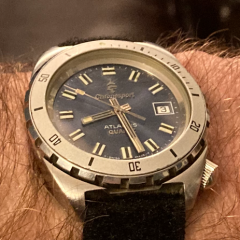-
Recently Browsing
- No registered users viewing this page.
-
Topics
-
Posts
-
By Neverenoughwatches · Posted
They do exist, i had a Lucerne front access a couple of years ago that had a false looking screw down case. At this stage if you are positive that the case and back are in one piece and the split stem is unsure then start thinking about pulling off that crystal. If its waterproof then it should have an armoured ring but in any case there is some good height on the sides to try a crystal lift tool. If it wont budge then some double sided tape stuck to your bench , place the watch face down and let the tape set for an hour before pulling up. If the crystal has a distinct dome to it look for a good matching surface to press into to get a positive seating for a good adhesive contact. -
If it's a push on back then it could have a notch in it for the stem which would mean the wording position would stay the same across all watches no matter how many times the back was removed. I've never seen a watch of this era, even a front loader, that doesn't have a removable back.
-
Rule of thumb I have is that if the dial is larger than the case back (or the thing pretending to be a case back) then it is probably a front loader. Appreciate it's sometimes not easy to tell, but lots of times it's obvious and you kick yourself for not realising it earlier.
-
By Latetothegame · Posted
Geotex, wow on the poor-man’s display back. Didn’t see that coming. Thanks for letting me off the hook for not realizing it. I greatly appreciate your time and advice. I am trying follow all of the advice people take the time to provide but being a relative novice I am not always sure of exactly how to execute it. I don’t want to go too far in the wrong direction. I have already found out how that ends. Your evidence regarding the wording on the case backs is compelling. It’s placed exactly the same as mine. What’s the odds that three watches could have case backs removed and replaced repeatedly and all end up in the exact same position. They are identical except for the fact that some idiot super glued a big nut in the middle of mine. Now, considering the last comment by Eccentric59, does it make sense to pull the Crystal to check to see if it has a Seiko movement with a release lever before I commit to using pliers on the crown? Nothing to lose with that approach I guess. Thanks to everyone again for your time! -
By eccentric59 · Posted
Might I suggest one of the iterations of Linux for older hardware? Mint cinnamon is very Windows-like with a much lower pain point for legacy devices.
-










Recommended Posts
Join the conversation
You can post now and register later. If you have an account, sign in now to post with your account.
Note: Your post will require moderator approval before it will be visible.